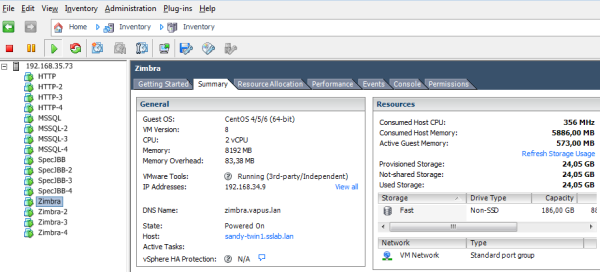LRDIMMs, RDIMMs, and Supermicro's Latest Twin
by Johan De Gelas on August 3, 2012 4:45 AM EST- Posted in
- IT Computing
- Intel
- Samsung
- Xeon
- Cloud Computing
- Supermicro
vApus Mark Mixed Performance
You might remember that we have two virtualization benchmarks, vApus Mark II and vApus Mark FOS. The first one is a virtualization benchmark with only Windows (mostly 2008) based VMs and third party proprietary applications; the second one has only Linux based VMs and contains strictly open source workloads so that third parties can verify our results if necessary.
You won't be surprised that as always both benchmarks have their limitations. Most enterprises run a mix of Windows and Linux VMs, and our benchmarks are not network and memory intensive enough. Remember that we developed them to test the newest multi-core processors from AMD and Intel. As 16GB or even 8GB DIMMs are way too expensive, we tried to keep the memory footprint rather modest as we would quickly run out of memory if we did not. Intel and AMD tend to send us their CPUs with the highest core count and the highest clock speeds inside an acceptable power budget.
Enter vApus Mark Mixed beta. We designed our third virtualization benchmark to be ultra realistic:
- A mix of Windows and Linux VMs
- High memory use
- Heavy I/O with lots of network traffic (>1 Gbit/s) and disk I/O
A vApus Mark Mixed beta tile consists of
- A LAMP virtual machine (Linux, Apache, MySQL, PHP) with four vCPUs and 4GB RAM
- An MSSQL2008 on Windows 2008 that gets eight vCPUs and 8GB of RAM
- A Zimbra VM with two vCPU and 8GB of RAM
- SPECJbb VM with eight vCPUs and 16GB of RAM
So, each tile needs 22 vCPUs and 36GB of RAM. If we test with three tiles, we would theoretically need 108GB. Note that this is theoretical. For example, we run with four instances of SPECJBB and each instance gets 4GB of RAM, but in reality, although those instances try to allocate 4GB of RAM, this does not mean that they effectively use 16GB actively. The same is true for the other VMs.











26 Comments
View All Comments
ddr3memory - Monday, August 6, 2012 - link
Your article is very interesting - and the first mainstream (and belated) examination of the LRDIMM (new standard - incompatible with RDIMMs) vs. HCDIMM (100% DDR3 RDIMM compatbile) choice for Romley.I have whittled down the use case for HCDIMMs/LRDIMMs and RDIMMs as follows:
The HCDIMM use case is at:
- 16GB at 3 DPC use
- 32GB (outperform both RDIMMs and LRDIMMs)
LRDIMMs are not viable at:
- 16GB (RDIMMs are better)
- 32GB (HCDIMMs are better)
RDIMMs are not viable at:
- 32GB (because they are 4-rank - trumped by LRDIMMs/HCDIMMs)
There is a reason the Netlist HCDIMMs were only released on the virtualization servers from IBM/HP - because at 16GB levels the only niche available for LRDIMM/HCDIMM vs. RDIMM is the 3 DPC space. This will expand considerably at 32GB to mainstream levels as soon as 32GB HCDIMMs are released (they are currently in qualification with IBM/HP and have not been announced yet - though maybe expected shortly).
I had created an infographic covering the memory choices - search the net for the article entitled:
Infographic - memory buying guide for Romley 2-socket servers
HCDIMMs are not available at SuperMicro (as they are for IBM/HP) - so I was surprised you even covered HCDIMMs (since the article is after all referring to the SuperMicro line of servers).
Casper42 - Friday, August 10, 2012 - link
BTW, Johan, I work for HP and asked some of the guys in ISS Technical Marketing why we don't send you our servers for eval like you get from SuperMicro and sometimes DellThey felt that you guys didn't do alot of Server Reviews, and that your readership wasn't generally the kind of folks that buy HP Servers.
So I am curious if you could spin up a poll or something in the future to prove them wrong.
If there is enough support I'm sure we can you some gear to play with.
I sometimes giggle when I see the stuff people on here get excited about in these reviews though. "Can you see the BIOS through IPMI?". Thats the kind of thing Compaq offered back with the RILOE II and have been integrated into the motherboard since iLO 1 which is like 4 or 5 years old at least.
iLO4 on the Gen8 line have taken that a step further and we now hook the Display system BEFORE POST starts so instead of an invalid memory config getting you a series of beeps, you now get a full blown screen either on local VGA or on the Remote Console that straight up tells you you have a memory mismatch and why. i have seen his demo'd with NO DIMMs even installed in the server and you still get Video and obvious status messages.
Casper42 - Friday, August 10, 2012 - link
Also you are about $2000 high on the HP SL unless I am missing something.I found these prices with QuickSpecs part numbers and Google, nothing magical inside HP.
Half of one of these:
http://www.provantage.com/hewlett-packard-hp-62923...
Includes 8 fans and 3 PS
2 of these
http://www.provantage.com/hewlett-packard-hp-65904...
2x2665 with 8GB
Comes to about $11,600
JohanAnandtech - Tuesday, August 14, 2012 - link
Hey Casper, contact me on my mail... thx!ad99 - Monday, April 1, 2013 - link
You say:a quad rank DIMM with 4Gb chips is a 32GB DIMM (4 Gbit x 8 x 4 ranks),but I think 4 Gbit x 8 x 4 ranks make only 16GB,is that right?ad99 - Monday, April 1, 2013 - link
No,4 Gbit x 8 x 4 ranks should be 128GB,not 32GB or 16GB,is that right?